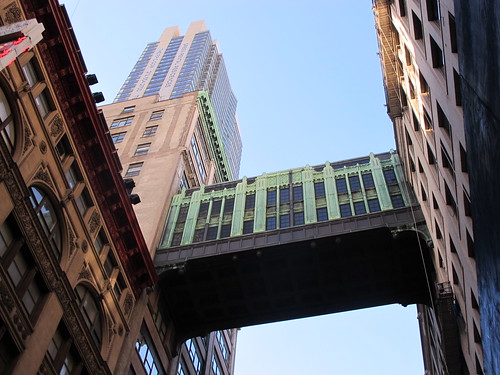West 32nd Street is hectic to say the least. Since it isn't on my daily commute, I usually only go to buy some inexpensive stuff that I "need" at Jacks, eat something amazing in Koreatown, and also to stare at the Gimbels Traverse, sometimes also referred to as the Gimbels Skybridge, a relic of retail history and architecture that focused on aesthetics and function.
 |
| Photo: 34SP, A. Kumer |
This Art Deco bridge, with its oxidized copper cladding make me happy as I try to navigate the insane pedestrian traffic on 32nd Street. In 1925 the retailer Gimbels bought the Cuyler building at 116 West 32nd Street to use primarily for their administrative offices. Built by the Cuyler Realty Co. in 1911, it sat across the street from the Gimbels flagship store (now Manhattan Mall) at 1275 Broadway. I've posted this picture before, but here is the Cuyler building a year after completion, and thirteen years before the Traverse.
 |
| Photo: MCNY |
Right after the purchase, Gimbels hired architects Richard Harold (R.H.) Shreve and William Lamb (later to become 2/3 of the Firm Shreve, Lamb & Harmon) to design the three-story passageway with copper cladding to connect the two buildings. (For 34th Street district enthusiasts, this firm also designed the Empire State Building, built in 1930-1931, and 1250 Broadway, built in 1967-1968; in our sister BID, Bryant Park, they designed 500 Fifth Avenue, built in 1931.)
The photo below shows West 32nd Street in 1977, including the traverse, the vertical Willoughby's sign (now Jack's), a vertical Gimbels sign, and at the southwest corner The Donald, now The Continental.
 |
| Photo: 1977, Whiskeygonebad flickr |
Here it is now from half a block further east.
 |
| Photo: 34SP, A. Kumer |
Surprisingly, the bridge isn't landmarked. To nominate it (or any other building) for landmark status, fill out this form and send it in to the Landmarks Preservation Commission.
Other sources:
NYT. "Cuyler Building Sold for $2,000,000 . . . " December 16, 1921
Bowery Boys
















































